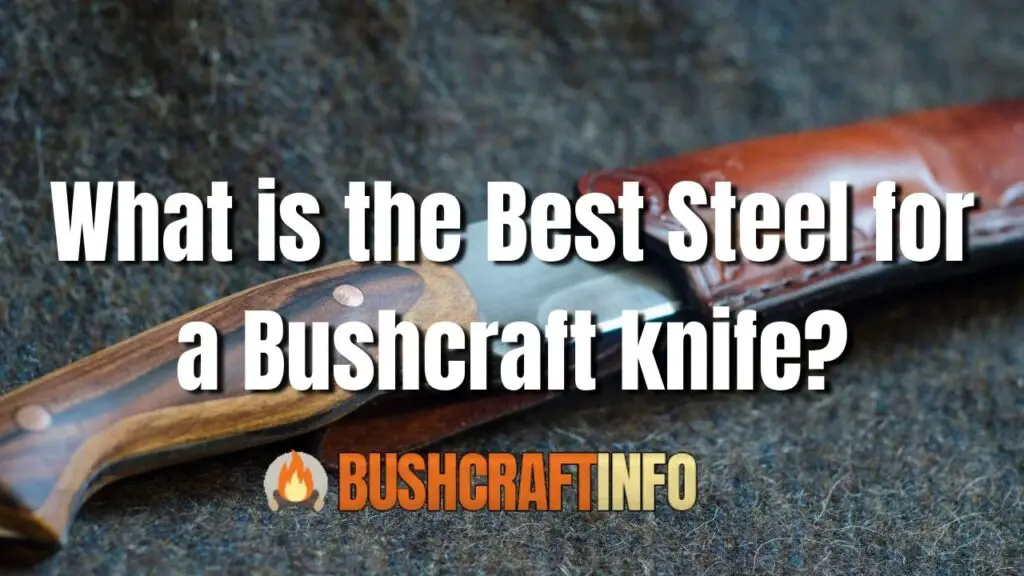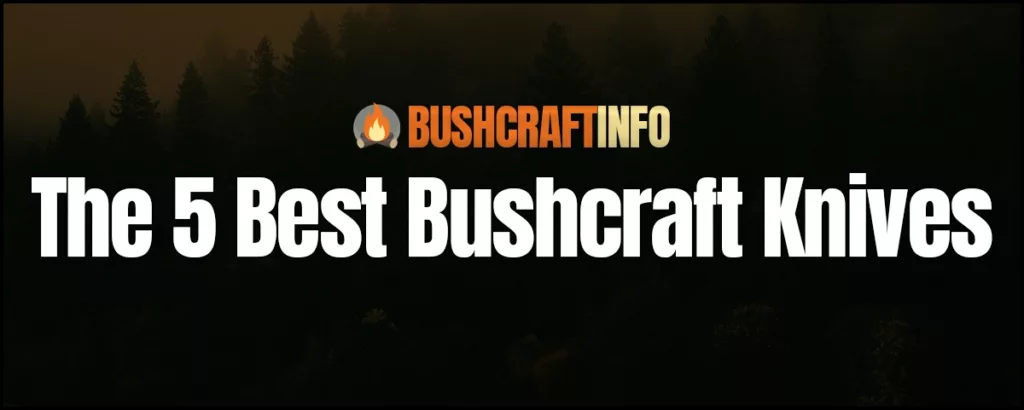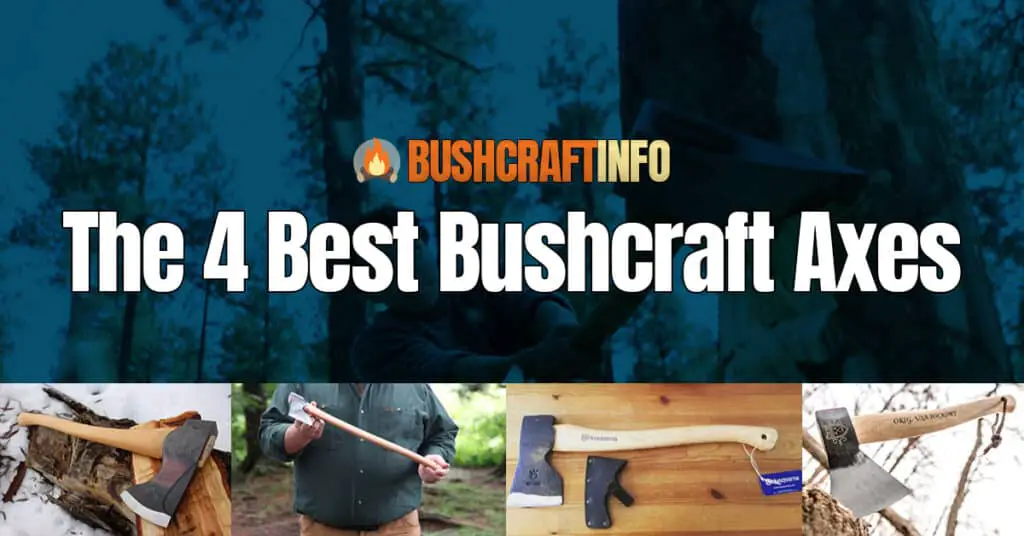If you are a beginner and just learning about knives, then, you might probably be wondering what is the best steel for a bushcraft knife?
The best steel for a bushcraft knife is carbon steel. Carbon steel allows the knife to be used as a striking tool for igniting fires. Besides that, it is also very easy to sharpen with the help of basic sharpening tools.
However, that’s not all. There’s a lot more to learn when it comes to knowing the best steel type for a bushcraft knife. Luckily, you have come to the right place because, in this article, I have explained everything in detail.
Here you will find some pros and cons of different types of steel used for making knives and understand their purpose. This way you will have a much better idea of why I am recommending carbon steel as the best steel for a bushcraft knife.
So without any further ado, let’s get into it!

What three kinds of steel are used to make knives?
Different types of material have been used for centuries for blade making. However, some of the most common types of material include carbon steel, stainless steel, tool steel, and alloy steel.
Let’s take a look at all of this one by one and understand their strengths and weaknesses before deciding which one is the best choice for making a bushcrafting knife.
Tool Steel
The first type of steel that is most commonly used for making blades is a tool steel. It consists of different numbers of alloys to ensure all the important properties that a good blade needs. Due to the different types of alloys used, this type of steel is generally very hard and sturdy and doesn’t break very easily.
Apart from that, its rough and tough structure also makes it excellent heat resistant due to which it is mainly used for cutting applications such as saw blades, etc. In addition to this, tool steel is not very good corrosion resistant as compared to carbon and stainless steel due to which it is not often used for knife making.
Carbon Steel
Apart from tool steel, carbon steel is one of the most widely used materials for knife making. It is known for its hardness and durability. The best thing about carbon steel blades is that they can easily be sharpened with simple tools and do not require a lot of effort.
However, it is also not very good when it comes to surviving rusting and corrosion. Another drawback of using carbon steel is that it is not able to hold its edge as long as some of the other steel types.
Some of the common examples of carbon steel include 1095 carbon steel, 1075 carbon steel, and O1 steel.
Stainless Steel
Another popular option for making a bushcraft knife is stainless steel. Unlike carbon steel, it does not contain iron or nickel. Stainless steel is known for its durability against staining. But, you need to beware of the name as it is stainless, not stain-free.
It means it can get rusted and corroded if you don’t take care of it properly. However, compared to carbon steel, it can survive better against rust and corrosion.
The main disadvantage of using stainless steel knives is that they are difficult to sharpen with regular sharpening tools. Due to this, stainless steel is not generally recommended for bushcraft and outdoor situations.
Is stainless steel good for bushcraft knives?
Now that you have learned about the different types of steel used in knives, you must be thinking about whether stainless steel is good for bushcraft knives or not.
The answer to this question depends upon the situation. For primary bushcraft knives, stainless steel is not recommended because it is harder to sharpen. However, when it comes to durability against rust and corrosion, it is the best choice.
This means if you are carrying more than one knife then you should carry a knife made of stainless steel. This will save your other knife from getting rusty while you are away from home. Another advantage is that they last longer than any other metal.
What is AUS 8 steel?
Aus8 (Austrian High Carbon) is an advanced version of AUS 5 – both being high-carbon steels. Austenitic Stainless Steel is essentially composed of chromium and molybdenum. The chromium helps in strengthening the steel without affecting its ability to resist fatigue cracking during repeated use. Molybdenum improves toughness and wearability so that the blade can withstand continuous usage.
This is why austenitic stainless steel is usually used in kitchen cutlery!
So basically, AUS 8 steel is one of the new stainless steels available nowadays that has been specially designed for commercial cutlery; i.e., knives. This steel is primarily developed by Austrian companies that manufacture all kinds of knives for commercial purposes. Such knives are especially durable, yet easy to maintain. They resist temperature changes, unlike regular steel.
So basically, Aus8 is a highly hardened stainless steel that will keep your knife intact even though you are in rough environments and/or doing heavy-duty activities. Its advantages include:
- Durable
- Nonreactive
- Hardness
- Excellent resistance to wear and tear
- Resistant to rust and corrosion
- Easy to repair
Is Damascus steel good?
There is a new trend (not very new but still) of chefs using cool-looking blades made of Damascus steel. The fancy design of the pattern on the blade provides a good look, but still, you may wonder if Damascus steel is good or not.
Damascus steel not only has an excellent looking and attractive design, but it is also very good for blades. The steel features a very durable structure that allows the blade to be flexible and maintain a sharp edge at the same time.
Moreover, the sharp edge of the blade can withstand rough and tough environments without any issue whatsoever. Though, Damascus steel requires a lot of effort due to which knives made of this material are usually expensive. This is one reason a lot of buscrafters avoid Damascus steel.
Why are stainless steel knives bad?
Stainless steel knives have their features, but they don’t have a very good reputation when it comes to survival and outdoor activities. Now the question arises, why are stainless steel knives bad despite the corrosion and rust-resistant nature of the steel?
The main reason why stainless steel knives are bad is because of their low hardness. Due to this, the edge of the knife rolls and wears easily; meaning, it is not able to survive rough environments.
Rolling edge can be reduced by using heavier edge geometry. However, it reduces the cutting ability and edge retention.
Due to these issues, stainless steel knives do not have a very good reputation when it comes to survival and bushcrafting knives.
However, they are still used as good kitchen and cutlery knives.
What steel holds the sharpest edge?
Sometimes you may also think what steel would hold the sharpest edge for knives. Well, the answer to this question is again the Carbon Steel. This type of steel is very tough due to its composition and, thus, holds the sharpest edge.
Besides that, carbon steel also allows you to sharpen your knife easily whenever you want and wherever you want. You will not need any fancy tools for sharpening knives made of carbon steel.
However, due to less chromium used in these blades, carbon steel is not very good when it comes to withstanding rust and corrosion.
Another advantage of carbon steel is that you don’t require extra care while sharpening since you don’t need to heat the knife. No heating means no danger for your safety and the knife’s life span.
In general, carbon steel is considered the best when it comes to making your survival and bushcrafting knife. It is also affordable compared to other types of steel.
Is titanium good for knives?
Yes! Titanium is very useful for creating bushcrafting knives. When combined with a high-quality alloy like 440C and 6A1V, titanium is capable of protecting the blade from rust and corrosion as well as providing a razor-sharp edge.
Titanium alloys are very hard and brittle, which makes them difficult to work with. Therefore, titanium is usually reserved for ornamental purposes, such as jewelry or dentistry. In addition, it is quite heavy so it doesn’t make a good choice if you’re trying to create a bushcrafting knife.
Nevertheless, there are some advantages of titanium over carbon steel, including its unique coloring effect and superior strength. However, when it comes to bushcrafting knives, carbon steel is more suitable due to its affordability and ease of use.
Conclusion
Knives made from high-quality materials, such as stainless steel, may have higher durability, but the downside is that they cost more than the ones made out of carbon steel. If you have made it this far, you may have got an answer to your question i.e. what is the best steel for a bushcraft knife.
To conclude the above information, the best steel for a buscraft knife is carbon steel because of its tough design, higher edge retention, and easy to sharpen nature. However, it is not very good when it comes to surviving rust and corrosion.
Therefore, I highly recommend carrying more than one knife with you whenever you are planning to go out on a bushcraft adventure. This will help you overcome almost every type of situation without any issue at all.
Was this post helpful?

Hey I’m Josh! I have been practicing Bushcraft for a little over 6 years now! I Started this website to review awesome bushcraft gear that I love as well as share information I have learned along the way!


